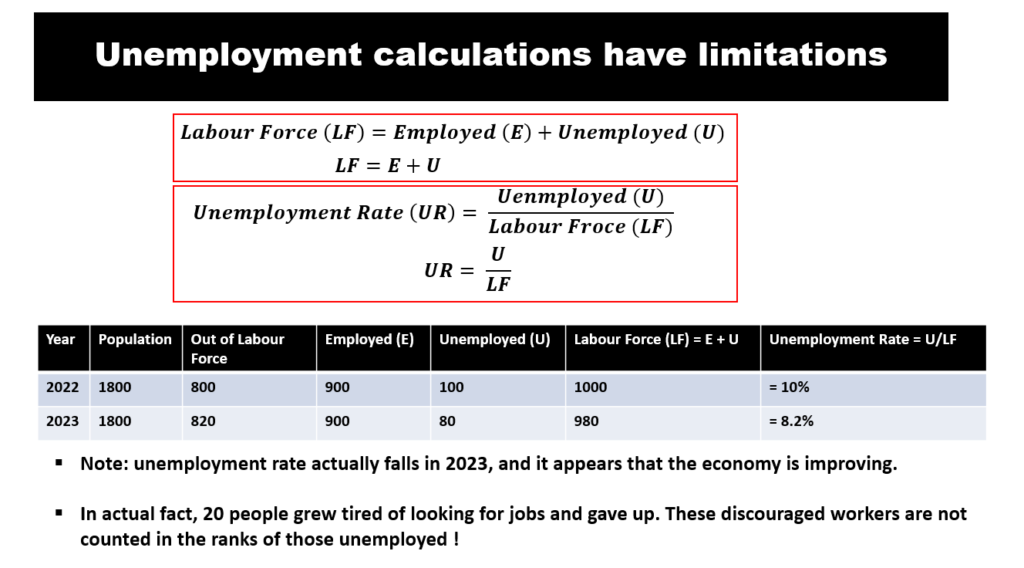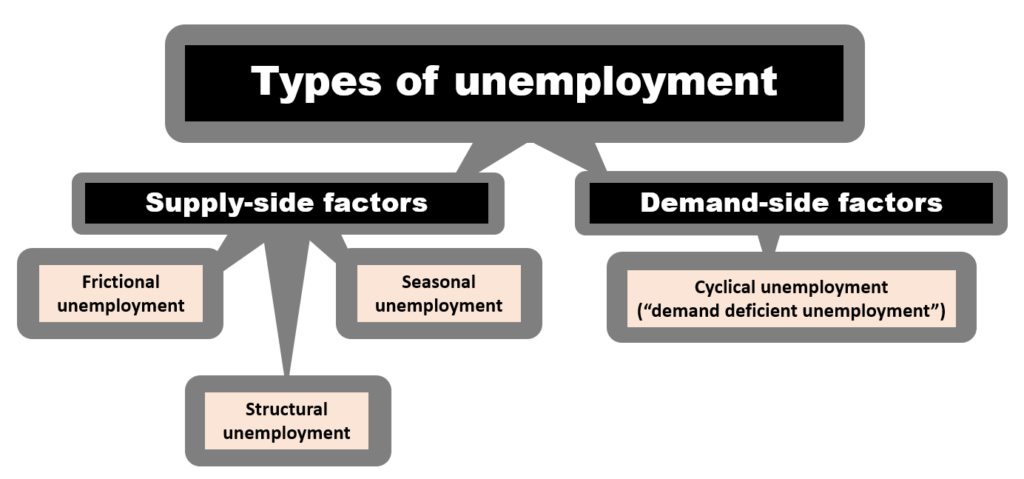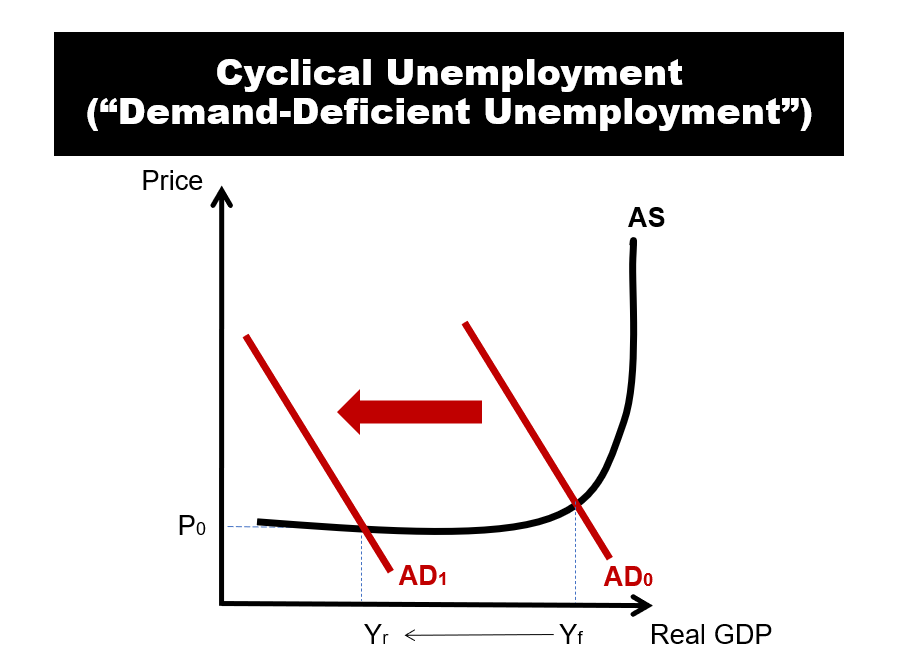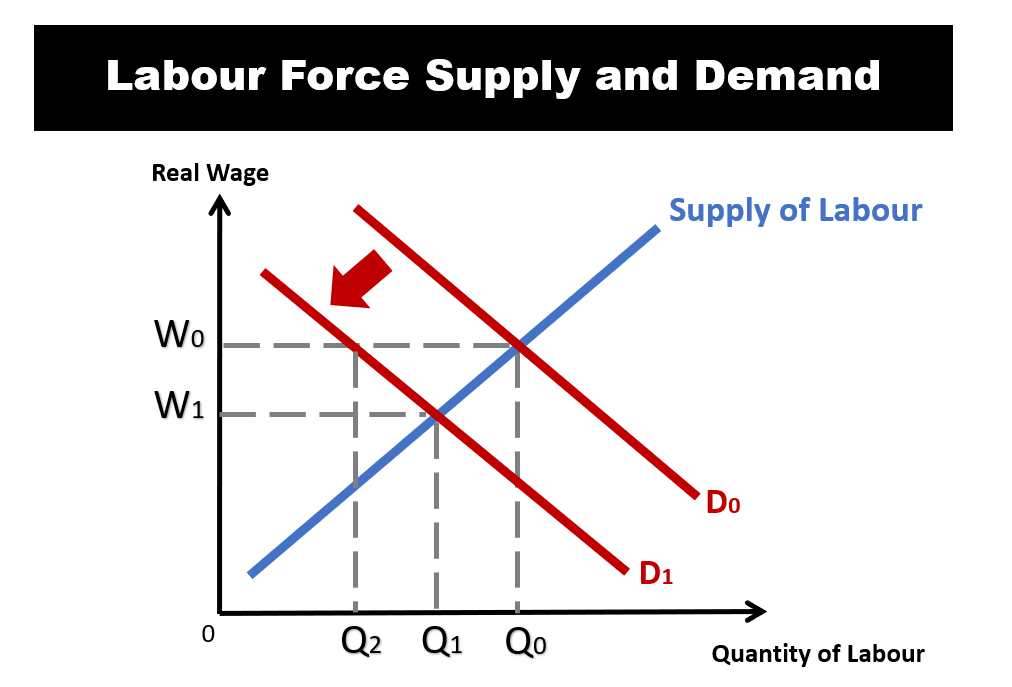Unemployment
Unemployment Rate
Officially, unemployment refers to a situation where people are willing to work, able to work, available to work, and of legal age to work, but are unable to find work. What this means is that we should not include people who are not supposed to be in the labour force, such as children and retirees. In addition, we should also not include people who are not looking for work (i.e. “voluntary unemployed”). Hence, the unemployment rate is simply the ratio of people in the labour force who are unable to find work over the total labour force. Depending on the root cause, we may use different terms – frictional unemployment, structural unemployment, seasonal unemployment, and cyclical unemployment – to describe this phenomenon.
The unemployment rate can provide a yardstick to gauge the performance of the economy. A healthy economy is one that has low unemployment. This means that people who wants to work can find jobs. People in the labour force are offering their labour, and that contributes to the production of goods and services. At the same time, they are also earning money to purchase goods and services, and that directly to spur consumption. However, using the unemployment rate as a metric alone can sometimes be misleading. This is illustrated in the example in the diagram.

The diagram illustrates a imaginary country with a population of only 1800 people. The economy worsens in 2022, as 20 people became so discouraged that they gave up looking for jobs. However, we note that unemployment rate in 2023 actually falls, giving the false impression that the economy is improving.
The reverse can also happen when the economy comes out of a recession where we can observe that the unemployment rate increases. That happens when the discouraged workers become active in seeking employment again.
Types of unemployment

#1 Frictional Unemployment
- Frictional Unemployment — refers to the unemployment that occurs when someone new enters the labour market or switches jobs.
#2 Seasonal Unemployment
- Seasonal Unemployment — The unemployment that occurs periodically (or seasonally) . E.g. agricultural jobs, teens employment during vacations.
#3 Structural Unemployment
- Structural Unemployment — The unemployment that is caused by fundamental underlying changes in the economy. This can create loss of jobs – especially for people with skills that are no longer in demand.
#4 Cyclical Unemployment ("Demand Deficient Unemployment")
- Cyclical Unemployment — The unemployment that occurs in the depending on the stages of the business cycle. i.e. during economy is contracting, unemployment rises, and when economy is expanding, unemployment falls.

- Cyclical unemployment happens when the economy transitions to a recessionary phase of the business cycle where the demand for various goods and services weakens. That is also why cyclical unemployment is also called “demand-deficient unemployment”.
- This means that there is less aggregate demand in the economy. This is illustrated by a shift in AD curve to the left from AD0 (the full employment level) to AD1. The unemployment will correspondingly drop by Yf-Yr. This is the size of the “demand-deficient unemployment”.
- As the aggregate demand drops when the economy enters into recession, the demand for labour will drop. This is illustrated as a leftward shift of the demand for labour curve from D0 to D1 in the Labour force supply and demand diagram.
- The drop in labour demand will result in less quantity of labour demanded from Q0 to Q1. However, wages are typically “sticky downwards”, and may not fully adjust to a drop in demand.
- If wages do not fall, then at the on-going wage at W0, firms will respond by cutting back jobs further to save costs. Hence the quantity of labour will eventually drop to Q2.

Costs of Unemployment
#1 Unemployment begets unemployment
- The longer a person stays unemployed the more difficult it is for him to find a job. Over time he will lose his skills, and also lose touch with the industry. On top of that, he ages and may face discrimination in the labour market.
#2 Unemployment creates social problems
- Prolonged unemployment causes human suffering and could break a person’s spirit. Careful research has shown that crime, mental illness, and general social unrest tend to be positively associated with unemployment.
- The long-term effects of high unemployment rates, in terms of the disillusioned who have given up trying to make it within the system and who contribute to social unrest, should be a matter of serious concern to the haves as well as the have-nots.
- May even increases poverty, heightens racial and ethnic tensions. Sometimes lead to violent social and political change e.g. Hitler in Germany.
#3 Loss of government revenue
- The government will lose tax revenue since income tax collection falls when the unemployment rate is high. In addition the government often has to pay out more unemployment benefits and also incur extra cost in running programs to generate jobs and re-train workers. All these are a drain on the national coffers.
Interventions to tackle unemployment
#1 Policies aimed at frictional and seasonal unemployment
- Improving information & job matching — making it easier for the unemployed to find jobs.
- Cutting back on unemployment benefits — this only applies to countries with unemployment benefits. This effectively increases the opportunity cost of unemployment, thereby forcing people to look more actively for work.
#3 Policies aimed at structural unemployment
- Incentivising training and education — to help people re-skill themselves in another area where there are jobs.
#3 Policies aimed at cyclical unemployment
- Using expansionary fiscal policy and expansionary monetary policy to increase aggregate demand.
